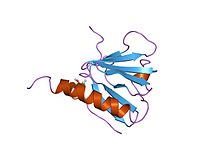PTB domain
| Phosphotyrosine-binding domain | |||||||||
|---|---|---|---|---|---|---|---|---|---|

Structure of the PTB domain of tensin1.
|
|||||||||
| Identifiers | |||||||||
| Symbol | PTB | ||||||||
| Pfam | PF08416 | ||||||||
| InterPro | IPR013625 | ||||||||
| CDD | cd00934 | ||||||||
|
|||||||||
| Available protein structures: | |
|---|---|
| Pfam | structures |
| PDB | RCSB PDB; PDBe; PDBj |
| PDBsum | structure summary |
| PTB domain (IRS-1 type) | |||||||||
|---|---|---|---|---|---|---|---|---|---|

irs-1 ptb domain complexed with a il-4 receptor phosphopeptide, nmr, minimized average structure
|
|||||||||
| Identifiers | |||||||||
| Symbol | IRS | ||||||||
| Pfam | PF02174 | ||||||||
| InterPro | IPR002404 | ||||||||
| SMART | PTBI | ||||||||
| SCOP | 1cli | ||||||||
| SUPERFAMILY | 1cli | ||||||||
| CDD | cd01204 | ||||||||
|
|||||||||
| Available protein structures: | |
|---|---|
| Pfam | structures |
| PDB | RCSB PDB; PDBe; PDBj |
| PDBsum | structure summary |
In molecular biology, Phosphotyrosine-binding domains are protein domains which bind to phosphotyrosine.
The phosphotyrosine-binding domain (PTB, also phosphotyrosine-interaction or PI domain) in the protein tensin tends to be found at the C-terminus. Tensin is a multi-domain protein that binds to actin filaments and functions as a focal-adhesion molecule (focal adhesions are regions of plasma membrane through which cells attach to the extracellular matrix). Human tensin has actin-binding sites, an SH2 (Pfam PF00017) domain and a region similar to the tumour suppressor PTEN. The PTB domain interacts with the cytoplasmic tails of beta integrin by binding to an NPXY motif.
The phosphotyrosine-binding domain of insulin receptor substrate-1 is not related to the phosphotyrosine-binding domain of tensin. Insulin receptor substrate-1 proteins contain both a pleckstrin homology domain and a phosphotyrosine binding (PTB) domain. The PTB domains facilitate interaction with the activated tyrosine-phosphorylated insulin receptor. The PTB domain is situated towards the N terminus. Two arginines in this domain are responsible for hydrogen bonding phosphotyrosine residues on an Ac-LYASSNPApY-NH2 peptide in the juxtamembrane region of the insulin receptor. Further interactions via "bridged" water molecules are coordinated by residues an Asn and a Ser residue. The PTB domain has a compact, 7-stranded beta-sandwich structure, capped by a C-terminal helix. The substrate peptide fits into an L-shaped surface cleft formed from the C-terminal helix and strands 5 and 6.
...
Wikipedia
